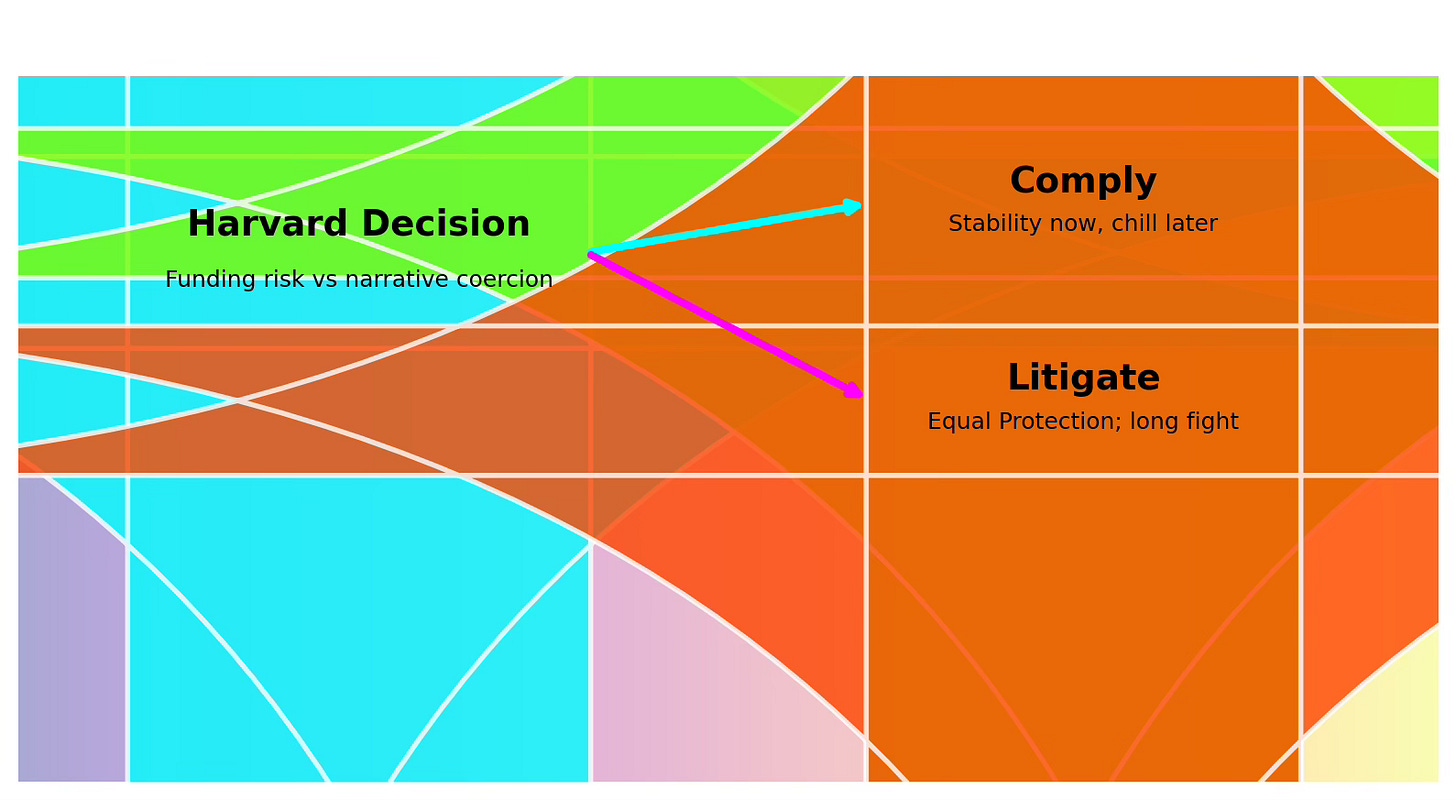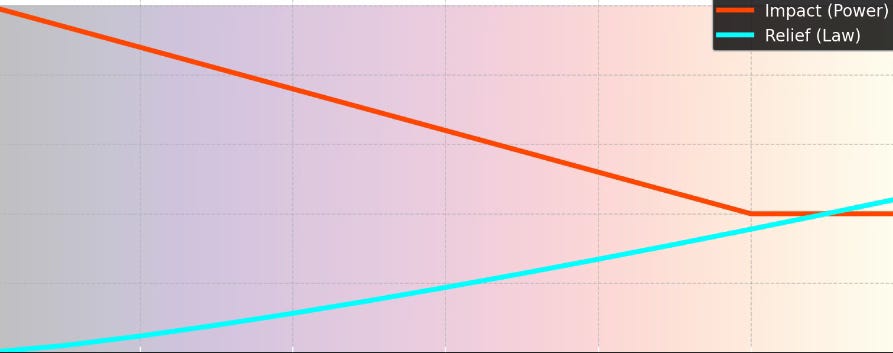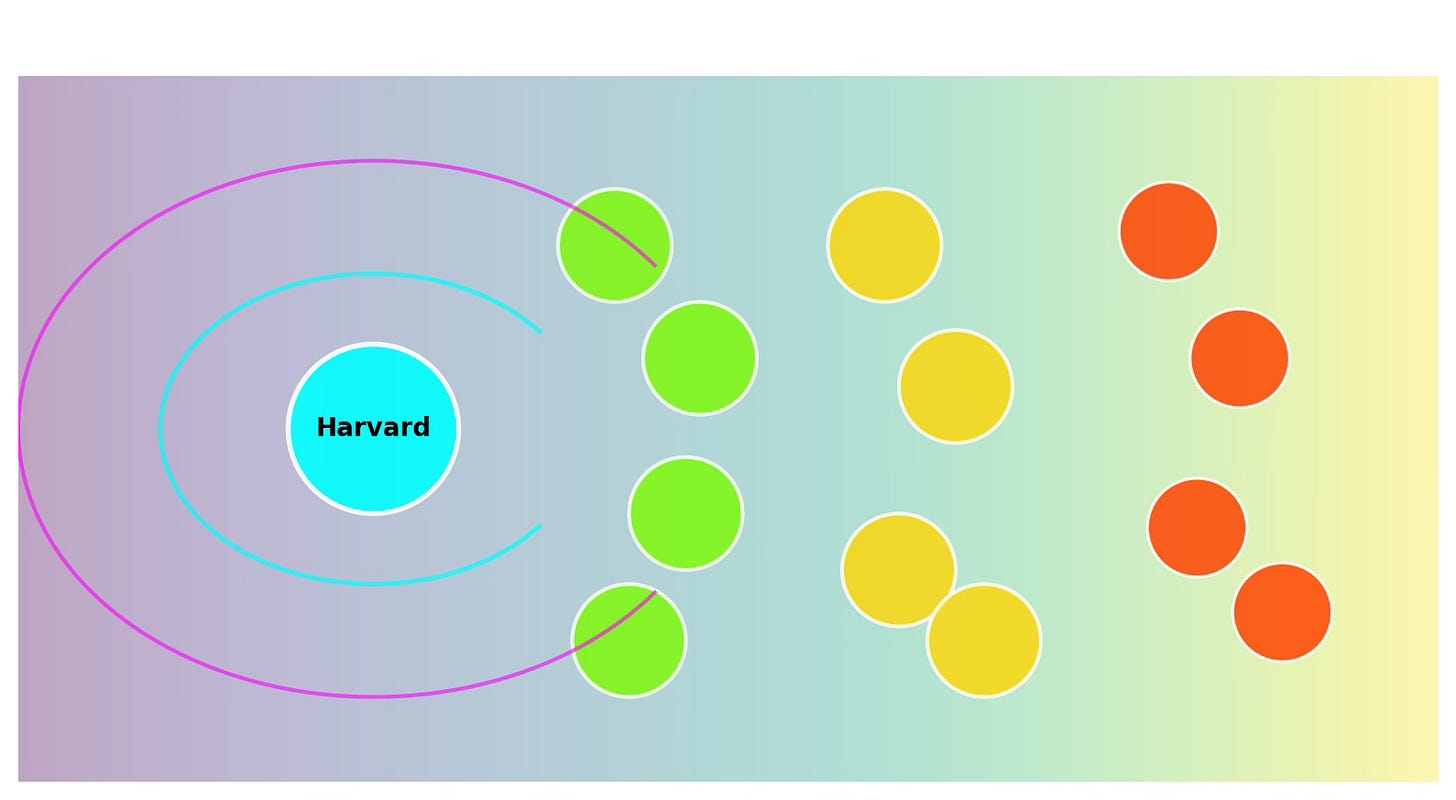MCAI Innovation Vision: The Rule of Law Under Coercive Narrative Governance in Trump v Harvard Patents
How Presidential Power Bypasses Equal Protection and Rewrites National Innovation Policy in Real Time
This companion study to National Innovation Policy, Putting Bayh-Dole Patents at a Crossroads (Aug 2025) is a foresight simulation conducted by MindCast AI, a predictive Cognitive AI firm. By modeling Cognitive Digital Twins of universities, industry, agencies, and courts, MindCast AI projects how institutions behave under coercive narrative governance. The study shows how the speed of executive action can outpace legal process, why Equal Protection claims may be strong in theory but weak in practice, and how these pressures ripple across the national innovation system. Also see The Tension Between Public Trust and Coercive Narrative Governance in Free Markets | Democracy (Jul 2025).
I. Introduction: Coercive Narrative Governance
Presidential narrative power does more than shape public opinion—it alters institutional behavior in real time. When the executive mixes messaging with discretionary enforcement, universities and industry partners adjust quickly, often before courts or legislatures weigh in. This is coercive narrative governance: compliance achieved through pressure and perception rather than law. It trades on urgency, not procedure.
In this setting, the battleground shifts. Universities are forced to respond within the frame set by the president’s narrative. Headlines, funding threats, and investigatory letters make compliance appear safer than resistance. Legal issues remain, but survival takes priority.
Coercive narrative governance makes law secondary and narrative primary. Institutions act on immediate risk, not eventual rulings. Compliance comes from the fear of loss, not judicial defeat. This explains why Equal Protection claims, though valid, may never be fully exercised in practice.
II. Power Moves Faster than Process
The key imbalance is speed. Presidential messaging and threats create instant reputational and financial effects. Courts and agencies move slowly, requiring months of filings, hearings, and deliberation. Universities must decide in days, making delayed judicial relief practically irrelevant.
Administrative law assumes time for record-building and review. Narrative governance operates on headlines and immediate consequences. By the time Equal Protection claims are tested in court, partnerships, funding, and reputation may already be damaged. Compliance becomes the rational path—not because it is legally required, but because delay is too costly.
Power’s advantage lies in timing, not in law. By acting faster than the courts, the executive can create outcomes that endure even if later overturned. The law follows after the harm is done.
III. The Equal Protection Dilemma
Targeting Harvard while leaving other universities untouched raises Equal Protection concerns. Selective enforcement violates the principle that like cases should be treated alike. But Harvard’s choice is between safeguarding $2B in federal funding or risking years of uncertain litigation. The legal case may be strong, but the incentives to pursue it are weak.
Courts have recognized that selective enforcement claims can succeed, especially when political animus is clear. Yet discovery and appeals take years. In the meantime, the practical damage—strained partnerships, nervous licensees, and negative publicity—forces immediate decisions. Law and pragmatism diverge.
This is how coercive narrative governance eclipses Equal Protection. The administration deters resistance not by winning in court, but by making noncompliance too costly. The claim is doctrinally valid but practically hollow. The chilling effect matters more than the ruling.
Contact mcai@mindcast-ai.com to partner with us on regulatory policy modeling and market foresight simulations. See our other national innovation policy work at www.mindcast-ai.com/s/national-innovation.
IV. Network Effects: Who Is Next?
Harvard is a hub in a national research network. Its licensing practices influence peers, its patents anchor partnerships, and its spinouts feed venture pipelines. A blow against Harvard radiates outward, raising fears of contagion. The question quickly becomes: who is next?
This does not require enforcement against every school. One high-profile case is enough to send signals across the system. Universities tighten terms, investors build in political-risk premiums, and startups face higher costs. Innovation slows because caution becomes the default.
Network effects amplify coercive narrative governance. Targeting one leader influences many others. The real deterrent is not the punishment itself but the system’s reaction to it. Fear moves faster than law.
The spread of fear across networks sets the stage for the scenarios that follow. When peers, partners, and startups all brace for potential enforcement, the probabilities of different outcomes shift accordingly. These network dynamics explain why compliance under protest dominates the forecast while more direct legal remedies remain secondary.
V. Scenarios and Forecasts
MindCast AI projects four likely outcomes over the next year. The most probable is compliance under protest: Harvard provides information, negotiates oversight, and keeps its funding. A targeted petition may emerge, but judicial relief, if any, comes too late to prevent near-term damage. Less likely outcomes include a judicial freeze or a policy rewrite, both slower than the immediate impact of coercive narrative governance.
Comply (Cure & Monitor) — 55%
Harvard accepts audit terms, keeps its $2B+ in federal research support, and stabilizes internally. This sets a precedent that encourages others to comply quickly. The chill spreads across the system.
Targeted Petition — 20%
Commerce or NIH selects a few patents, likely in biotech, for a march-in test. Even if the petition fails, uncertainty slows deals and unsettles licensees. The process itself becomes the punishment.
Judicial Freeze — 15%
Harvard sues and wins limited relief. The ruling comes late, after months of disruption. Courts restore limits, but the damage to confidence remains.
Policy Rewrite — 10%
Congress changes Bayh-Dole, adding criteria such as price or access. This unfolds slowly but permanently reshapes university licensing. The statutory compact no longer looks the same.
The forecast highlights the limits of law under coercive narrative governance. Even if relief arrives, the damage occurs first. The real driver is speed, not statute. The clock is the lever of power.
VI. Action: Closing the Time Gap
Universities and industry must learn to respond to narrative pressure as quickly as it arises. They need pre-packaged compliance evidence, coordinated communications, and rapid legal strategies. The goal is to shorten response times so narrative coercion cannot monopolize perception.
Preparation matters. Shared templates, pooled legal efforts, and aligned messaging can reduce the executive’s time advantage. The point is not to erase risk, but to prevent it from dominating the first 30 days of enforcement.
Closing the time gap restores the power of constitutional claims. It makes Equal Protection meaningful again. Without it, coercive narrative governance will keep outpacing process, reshaping innovation policy by default. Law must move as fast as power, or lose its hold.






